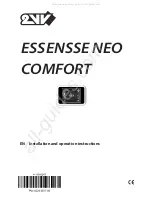
6 | Commissioning
14 / 32
0870207738_RA_RC0400-0630C_USA_-_IM_en
CAUTION
Vacuum pump may be loud.
Risk of damage to hearing!
If people are present in the vicinity of a non-acoustically-insulated vacuum pump over
extended periods:
• Make sure that ear protection is being used.
• Make sure that the installation conditions (see
Installation Conditions [
►
7]
) are be-
ing followed.
Version with water-oil heat exchanger:
• Open the water supply.
• If the cooling water inlet is equipped with a water bypass valve (WBV), open it for
approx. 90 seconds before the first machine start-up.
• Make sure that cooling water requirements are fully complied with, see Cooling
Water Connection (Optional).
• Switch on the vacuum pump .
• Minimum time between starts and maximum number of starts per hour are dependent
upon the motor and coupling type used. Please consult the factory for recommenda-
tions.
• Make sure that the operating conditions are complied with, see
Technical Data
[
►
27]
.
• After few minutes of operation, check the oil level and top up if necessary. See
Oil
Level Inspection [
►
16]
.
As soon as the vacuum pump is operating under normal operating conditions:
• Measure the motor current and record it as reference for future maintenance and
troubleshooting work.
6.1 Conveying Condensable Vapours
Water vapour within the gas flow is tolerated within certain limits. The conveyance of
other vapours shall be agreed upon with Busch.
If condensable vapours are to be conveyed:
Warm the pump up for 30 minutes before exposing it to the process, and allow it to run
dry for 30 minutes before turning it off. Make sure to run the pump with the gas ballast
open.
START
Warm up the
vacuum pump
for 30 minutes
Allow the pump
to run dry for 30
minutes
• Open the inlet valve
• Perform the process
• Close the inlet valve
END
Note:
• Make sure to run the pump with the gas ballast open















































